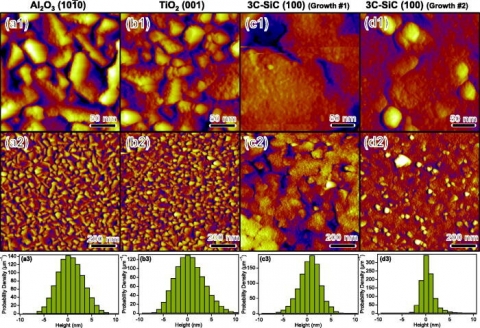Reduction of surface roughness emittance of Cs₃Sb photocathodes grown via codeposition on single crystal substrates
In this paper we fabricated thin films of the high efficiency photocathode material Cs3Sb on different single-crystalline substrates. These samples are extremely air sensitive and have to be kept in very low residual gas pressure to maintain their properties. We transferred our samples using a special vacuum suitcase to a scanning tunneling microscope, always in very strict vacuum conditions, capable of measuring the surface of conducting samples with atomic resolution, to obtain a map of the surface of our samples and study how the choice of the crystalline material could change the morphology of the film. Using the maps of the film surface we could estimate how the asperities on the photocathode surface would increase the momentum spread of the photoemitted electrons in a high electric field, thus reducing the brightness of electron beams. We discovered that large island size and reduced roughness in samples deposited on SiC substrates reduce this spurious effect by a factor of 17.
The CBB Beam Production objective is to develop photocathodes for high peak-intensity beam generation with < 5 meV MTE. Our results show that lower effective MTEs (momentum spread of the electrons) can be achieved thanks to the choice of single crystalline substrates that promote the growth of smoother photocathodes with large islands.
High peak-intensity beams are crucial for single-shot ultrafast electron microscopy, capable of capturing the structure of large molecules evolving on very small time-scale with a single electron pulse, and to achieve more efficient free-electron lasers that can emit high intensity radiation in the x-ray range.
Cs3Sb and related compounds have been used for a long time without a real study of the growth mechanisms and how they affect the nanostructure of the photocathode materials. This study brings us closer to synthesizing these technologically important compounds in ordered form. This would allow better performances, more controlled properties and the opportunity to achieve a better theoretical understanding of the photoemission process.
Reference:
A. Galdi, J. Balajka, W. J. I. DeBenedetti, L. Cultrera, I. V. Bazarov, M. A. Hines, and J. M. Maxson, “Reduction of surface roughness emittance of Cs3Sb photocathodes grown via codeposition on single crystal substrates,” Appl. Phys. Lett., vol. 118, no. 24, p. 244101, Jun. 2021, doi: 10.1063/5.0053186.

